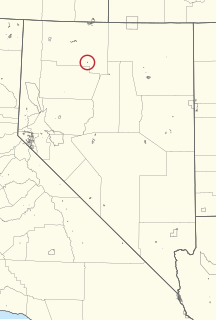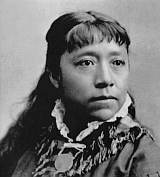Related Research Articles

Winnemucca is the only incorporated city in, and is the county seat of, Humboldt County, Nevada, United States. As of the 2010 census, the city had a total population of 7,396, up 3.1 percent from the 2000 census figure of 7,174. Interstate 80 passes through the city, where it meets U.S. Route 95.

Sarah Winnemucca Hopkins was a Northern Paiute author, activist(lecturer) and educator. Her maiden name is Winnemucca.

The Northern Paiute people are a Numic tribe that has traditionally lived in the Great Basin region of the United States in what is now eastern California, western Nevada, and southeast Oregon. The Northern Paiutes' pre-contact lifestyle was well adapted to the harsh desert environment in which they lived. Each tribe or band occupied a specific territory, generally centered on a lake or wetland that supplied fish and waterfowl. Communal hunt drives, which often involved neighboring bands, would take rabbits and pronghorn from surrounding areas. Individuals and families appear to have moved freely among the bands.

Winnemucca Lake is a dry lake bed in northwest Nevada that features the oldest known petroglyphs in North America. Located astride the border between Washoe and Pershing counties, it was a shallow lake until the 1930s, but was dried when a dam and a road were built that combined to restrict and block water flow. It was formerly designated as a National Wildlife Refuge, but its status as a refuge was removed due to the lack of water.
According to Paiute oral history, the Si-Te-Cah, Saiduka or Sai'i are a legendary tribe whose mummified remains were allegedly discovered under four feet of guano by guano miners in what is now known as Lovelock Cave near Lovelock, Nevada, United States. Although the cave had been mined since 1911, miners did not notify authorities until 1912. The miners destroyed many of the artifacts, but archaeologists were still able to retrieve 10,000 Paiute artifacts from the cave. Items included tule duck decoys, sandals, and baskets, several dating back over 2000 years.

Winnemucca was a Northern Paiute war chief. He was born a Shoshone around 1820 in what would later become the Oregon Territory.

Fort Churchill State Historic Park is a state park of Nevada, United States, preserving the remains of a United States Army fort and a waystation on the Pony Express and Central Overland Routes dating back to the 1860s. The site is one end of the historic Fort Churchill and Sand Springs Toll Road. The park is in Lyon County south of the town of Silver Springs, on U.S. Route 95 Alternate, eight miles (13 km) south of U.S. Route 50. Fort Churchill was designated a National Historic Landmark in 1961. A 1994 park addition forms a corridor along the Carson River.
Egan is the American name given to Pony Blanket. Pony Blanket was a Northern Paiute leader in the Oregon Country in the 19th century.

The Winnemucca Indian Colony of Nevada is a federally recognized tribe of Western Shoshone and Northern Paiute Indians in northwestern Nevada.

Mary Tyler Peabody Mann was a teacher, author, mother, and wife of Horace Mann, American education reformer and politician.
Truckee, also known as Captain Truckee, Wuna Mucca, The Giver of Spiritual Gifts, Old Winnemucca, One Moccasin, Onennamucca, One-ah-mucca), or Old Chief Winnemucca, was a medicine chief of the Northern Paiute people and an influential prophet. How he gained the name Truckee is up for debate as different accounts credit different people/groups with giving Winnemucca the nickname. Chief Truckee lead his people through a rapidly changing time in California history while also becoming one of the most respected chiefs both by his people and to an extent by the settlers who he often aided. For simplicity he will be referred to as Truckee or Old Winnemucca for the rest of the Article.
The Williams Station massacre was an incident that ignited the Pyramid Lake War of 1860.
Native American literature is literature, both oral and written, produced by Native Americans in what is now the United States, from pre-Columbian times through to today. Famous authors include N. Scott Momaday, Leslie Marmon Silko, Simon Ortiz, Louise Erdrich, Gerald Vizenor, Joy Harjo, Sherman Alexie, D'Arcy McNickle, James Welch, Charles Eastman, Mourning Dove, Zitkala-Sa, John Rollin Ridge, Lynn Riggs, Diane Glancy, Hanay Geiogamah, William Apess, Samson Occom, et al. Importantly, it is not "a" literature, but a set of literatures, since every tribe has its own cultural traditions. Since the 1960s, it has also become a significant field of literary studies, with academic journals, departments, and conferences devoted to the subject.
The Cedarville Rancheria is a federally recognized tribe of Northern Paiute people in Modoc County, California, about 30 miles (48 km) south of the Oregon border. Cedarville Rancheria is 26 acres in Cedarville. The tribal headquarters is located 20 miles away from the Rancheria in Alturas. The tribe has an environmental protection agency that is dedicated to keeping the Rancheria clean and teaching children how to protect and care for the planet.

Numaga was a Paiute leader during the Paiute War of 1860 that centered on Pyramid Lake in what is now Nevada in the United States. The war was caused by an influx of miners and ranchers after silver was discovered in the Comstock Lode near to Carson City. The newcomers assaulted the Paiutes and destroyed their foods supplies. When the Paiutes responded, the U.S. Army used force to suppress them. Both before and after the war, Numaga was a strong advocate of peace and did much to reduce the violence on both sides. He died of tuberculosis, a "white man's disease", in 1871.

The Fort McDermitt Paiute and Shoshone Tribe is a federally recognized tribe of Northern Paiute and Western Shoshone peoples, whose reservation Fort McDermitt Paiute and Shoshone Tribes of the Fort McDermitt Indian Reservation spans the Nevada and Oregon border next to Idaho. The reservation has 16,354 acres (6,618 ha) in Nevada and 19,000 acres (7,700 ha) in Oregon.
The Battle of Mud Lake/Mud Lake Massacre, also known as the "Skirmish at Mud Lake", occurred on 14 March 1865 during the Snake War in northwest Nevada Territory, at present-day Winnemucca Lake, Nevada, during the closing months of the concurrent American Civil War.
The Indian princess is usually a stereotypical and grossly inaccurate representation of a Native American or other Indigenous woman of the Americas. The term "princess" was often mistakenly applied to the daughters of tribal chiefs or other community leaders by early American colonists who mistakenly believed that Indigenous people shared the European system of royalty. This inaccurate portrayal has continued in popular animation, with characters that conform to European standards of beauty, with the most famous misrepresentation being that of Pocahontas. Frequently, the "Indian Princess" stereotype is paired with the "Pocahontas theme" in which the princess "offers herself to a captive Christian knight, a prisoner of her father, and after rescuing him, she is converted to Christianity and live with him in his native land." - a false narrative that did not even happen that way to the real child who inspired the Pocahontas stories. The phrase "Indian princess", when used in this way, is often considered to be a derogatory term, a type of racial slur, and is deemed offensive to Native Americans.

William Vance Rinehart was an American soldier who served as a Union Army officer in both the 1st Oregon Volunteer Cavalry Regiment and 1st Oregon Volunteer Infantry Regiment during the American Civil War. He was later appointed as Indian agent at the Malheur Indian Reservation in eastern Oregon. Rinehart then moved to Seattle, Washington where he engaged in business and was active in state and local politics. He was elected to Washington state's first legislature, serving as a state senator from 1889 through 1890.
References
- 1 2 3 4 5 Voices from the Gaps: "Sarah Winnemucca Hopkins", University of Minnesota website, accessed 11 February 2014
- ↑ Omer Stewart, Review: "Gae Whitney Canfield, 'Sarah Winnemucca of the Northern Paiutes', Norman, OK: University of Oklahoma, 1983", Journal of California and Great Basin Anthropology, 5(2), 1983, accessed 12 February 2014
- 1 2 3 4 5 Lukens, M. (1998). Her "Wrongs and Claims": Sarah Winnemucca's Strategic Narratives of Abuse. Wíčazo Ša Review, 93-108.
- 1 2 3 Lape, Noreen Groover. "I Would Rather Be with My People, but Not to Live with Them as They Live": Cultural Liminality and Double Consciousness in Sarah Winnemucca Hopkins's" Life among the Piutes: Their Wrongs and Claims." American Indian Quarterly (1998): 259-279.
- ↑ Winnemucca, Sarah (1883). Life Among the Piutes: Their Wrongs and Claims. G.P. Putnam's Sons.